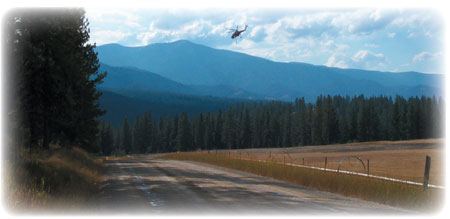Flagging Operations To Stop Traffic for Helicopter Activities
Application Notes
Intermittent flagging operations may be needed to stop traffic when helicopter operations affect road users.
A flagger must be trained and certified by a State- or Federal-approved training and certification agency in safe traffic control practices and public contact techniques. Flaggers shall wear high-visibility safety apparel that meets the Performance Class 2 or 3 requirements of ANSI/ISEA 107–2004 (or current edition).
Use the BE PREPARED TO STOP and the flagger symbol signs during all flagging operations. Remove, cover, or turn signs face down when traffic is not being flagged.
The advance warning sign FIRE ACTIVITY AHEAD should be visible at all times, even when flagging operations are suspended.
The flagger should:
- Never stand in a lane used by moving traffic. Stand either on the shoulder adjacent
to the lane being controlled or in the closed lane before stopping road users.
- Only stand in the lane being used by moving traffic after road users have stopped.
- Be clearly visible to the first approaching road user at all times.
- Be visible to other road users.
- Be stationed sufficiently in advance of the flight path to allow vehicles time to
stop. Use table 3 on page 26.
- Stand alone, away from other workers, work vehicles, or equipment.
Where adequate sight distance is available for the reasonably safe handling of traffic, the use of one flagger may be sufficient.


Flagging Operations To Stop
Traffic for Helicopter Activities
*Obtain distance from table 1 (page 8).
***Obtain distance from table 3 (page 26).
(Click here for long description)
See pages 26 through 28 for flagger requirements.
Intermittent Flagging Operations at IntersectionsApplication Notes
Intermittent flagging operations may be needed during shift changes or at other critical times of the incident operation.
A flagger must be trained and certified by a State- or Federal-approved training and certification agency in safe traffic control practices and public contact techniques. Flaggers shall wear high-visibility safety apparel that meets the Performance Class 2 or 3 requirements of ANSI/ISEA 107–2004 (or current edition).
Use the BE PREPARED TO STOP and the flagger symbol signs during all flagging operations. Remove, cover, or turn signs face down when traffic is not being flagged.
The advance warning sign FIRE ACTIVITY AHEAD should be visible at all times, even when flagging operations are suspended.
The flagger should:
- Never stand in a lane used by moving traffic. Stand either on the shoulder adjacent
to the lane being controlled or in the closed lane before stopping road users.
- Only stand in the lane being used by moving traffic after road users have stopped.
- Be clearly visible to the first approaching road user at all times.
- Be visible to other road users.
- Be stationed sufficiently in advance of the intersection to allow vehicles time to
stop. Use table 3 on page 26.
- Stand alone, away from other workers, work vehicles, or equipment.
At spot lane closures where adequate sight distance is available for the reasonably safe handling of traffic, the use of one flagger may be sufficient.


Intermittent Flagging Operations
at Intersections
*Obtain distance from table 1 (page 8).
**Obtain distance from table 2 (page 9).
***Obtain distance from table 3 (page 26).
(Click for long description)

